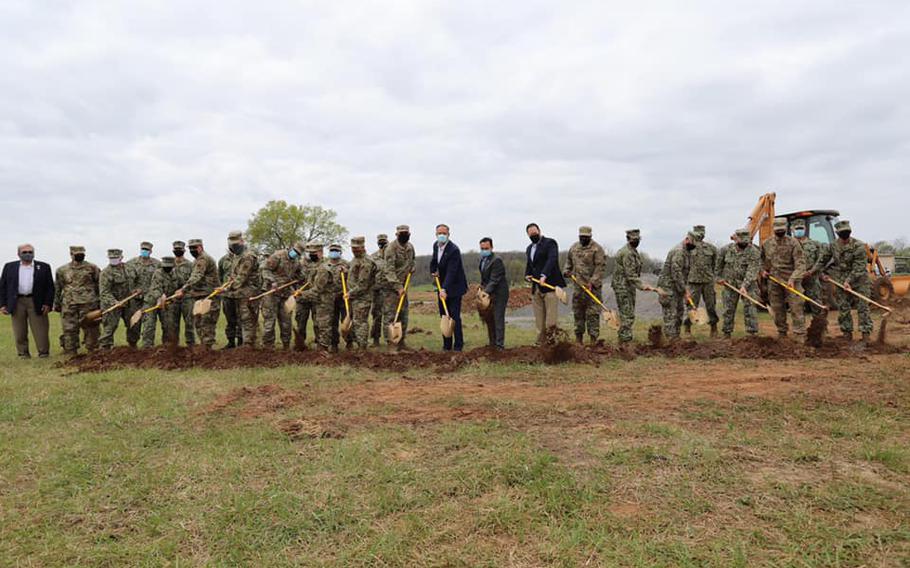
The Cherokee Nation and Oklahoma Air National Guard broke ground on the future site of homes for veterans, which will be part of the Cherokee Veterans Housing Initiative through the U.S. Department of Defense Innovative Readiness Training program (Cherokee Nation/Facebook)
A joint project between the Cherokee Nation and Oklahoma Air National Guard is serving two purposes: providing Cherokee veterans with housing and training for military units to improve their deployment readiness.
Through the Cherokee Veterans Housing Initiative and U.S. Department of Defense Innovative Readiness Training programs, 21 news homes are being built over the next three years in the Mige Glory housing addition. A distinguished visitors day was held Wednesday, when tribal officials and members of the Air Force were invited to tour the construction site and learn what type of training opportunities are available for service members.
Master Sgt. Mitchell Sisco, operations manager for the IRT program and a Cherokee Nation citizen, said people can think about what it takes to put a Boeing C-17 in the air, and how the same coordination among multiple levels of personnel applies when members are overseas. This program helps units prepare for jobs they may face during wartime missions.
“Every single aspect of this mission just generates more and more training,” Sisco said. “That’s a big, often overlooked thing. A value multiplier is what we are.”
An important aspect of the program is for operations managers like Sisco to be open and honest with community partners, he said. So while the program provides communities with key services, the Guard’s main purpose is to refine mission-essential skills in complex environments.
“We’re here to train. Through our training we will build homes, but the whole reason we are here is to increase our readiness through training,” Sisco said.
The housing addition project is offering civil engineering training for construction purposes, which is something most military bases can’t provide. Most construction projects are contracted out, as are services Force Support Squadron members would provide on deployment, said Capt. Miles Shephard.
“It’s the same case with the cooks in the kitchen,” he said. “Most of them are contracted out, so they don’t get any opportunity to actually use the grills, the fryers, and cook the food. Here, this is a really unique opportunity; they get to do that. They’re training on cooking real food and serving to real folks, which is great training for them and it’s a morale booster. That’s why you join the military; that’s your job and this gives [FSS] folks a chance to do their job.”
The project involves HVAC, plumbing, and electrical work. And with hundreds of different engineers rotating through the site — coming from OANG, the Army National Guard, the Navy Reserve, and the Air Force Reserve Command — the project allows them to prepare for unexpected obstacles and make contingency plans. Sisco said the project may bring people from New York to build the materials, guardsmen from Puerto Rico lay the materials out, and service members from Florida or Alaska finish the project.
“If you’ve ever been deployed, you know. You fall in and usually have to fix what the crew before you did, or you have to try and carry on,” he said. “Suddenly a bunch of material comes in that you weren’t tracking and you’re not even really sure what it was for. So you’ve got to figure out what that is. That’s not material you would have ordered to do that job, but the job’s got to get done. So this is a great, low-threat way to figure out how to overcome those obstacles.”
The trainees get days to see the town, the area’s abundant recreational opportunities, and find out more about Cherokee culture, too. Some have been able to visit Cherokee Nation museums and learn about Native American heritage, as many members are not accustomed to living in Native communities. Sisco said it also provides them with training on how to behave socially with people of a different culture, adding that he himself has been asked whether he grew up living in a tipi.
“It’a an opportunity for people to immerse themselves in a different culture. It’s low-threat, so it’s a great opportunity to train,” he said. “If you’re going to trip over something, do it here; don’t do it whenever you’re overseas and that same faux pas might be life or death to someone.”
The first seven single-family homes are set to be complete in the first year of the project. The Housing Authority of the Cherokee Nation will retain ownership of all the homes, so when a veteran is no longer in need of housing, another homeless or at-risk vet can move in.
“Disproportionately, Native veterans are among the homeless veteran population, and the more we can do in the area of housing, whether it’ emergency rental assistance or this type of long-term housing solution, the better, and we should keep focusing on solutions for this problem,” Principal Chief Chuck Hoskin Jr. said at the time of the groundbreaking. “Partnering with these military units, we have the tools and talent to make a big difference.”
(c)2021 the Tahlequah Daily Press (Tahlequah, Okla.)
Visit the Tahlequah Daily Press (Tahlequah, Okla.) at www.tahlequahdailypress.com.
Distributed by Tribune Content Agency, LLC.